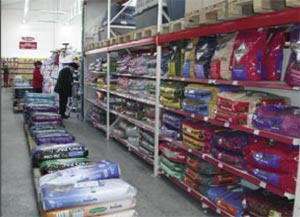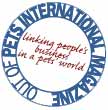Although Russia continues to lag behind global developments in the pet retail trade, the Russian pet industry has a variety of segments, like the pet industries in the rest of the world. A survey conducted in 2003 showed that most customers (42.4%), buy pet products in specialty shops. For more detailed information on Russian retail outlets, please see the article on Russian Pet Market in Pets International Magazine, no. 3, 2004.
As an economic sector, the Russian pet business is slightly over a decade old, however pets have always been loved in Russia. Families usually kept dogs and cats, as well as birds, fish and small mammals, and pet shops have a long history in Russia.

What were they able to offer their customers?
First, there were the pets themselves, such as birds, hamsters, guinea-pigs. They also sold cages, hay, grain, dog collars and leads. No products was available for cats. There were Pet Bazaars in large cities which offered a wider variety of pets and products for them.
Some shops have endured for a long time; they continue to operate and are quite popular because of their long- standing reputation, in spite of the fact that they may be poorly run.
Until the early 1990s, the concept of prepared pet food, various accessories and other pet products was entirely unknown. The first modern pet shops appeared in Russia soon after the economic reforms with the advent of pet food manufactured by Mars and numerous veterinarian medicines from leading international producers.
The retail network is fairly well developed in Moscow with about 170 pet shops at present. Many occupy very small subterranean spaces of 10 to 20 m2. Still, as is the case in most other countries in the world, newer, large pet supermarkets crop up and tend to drive out these small outlets. For example, about 20% of the pet shops in Moscow closed in 2003. Meanwhile, during the same year, five large modern pet stores opened, including the first Bash & Carry pet shop in Russia, from the Beethoven chain. Pet retail chain stores, such as Markvet, Beethoven and 38 Parrots, are experiencing a stable pattern of development in Moscow. Though there are pet shops in the province run by a single owner, they may hardly be considered to be chain stores as they lack any kind of unified system in their operations.
There are many pet shops in St. Petersburg as well, mainly owned by wholesale companies, though they are predominantly tiny outlets. At the same time, both large pet shops and pet departments are also opening up in shopping centers.
There are developments in pet chain stores in Yekaterin- burg and Vladivostok where people earn more than the average income earned by those living in the countryside. There are fairly good pet shops with a varied inventory. It is even prohibited to weigh pet food in Yekaterinburg, something that is a common practise in other cities.
Smaller Russian towns generally have one or two pet shops owned by a local wholesaler that also runs kiosks at public markets.
It is worth noting that the quality of products in the range offered by the pet shops has changed. Pet food is a particularly good example of this. The pet shops would rather sell good quality, professionally manufactured food. Pet stores have appeared in Moscow that offer exclusively super premium and premium foods. The pet shops have become well equipped and have introduced many innovations to make shopping enjoyable. Pets are now also even permitted in stores, to shop together with their owners.

More and more Russian pet owners have come to realise that it is better to buy industrial food and other products for their pets. Sociological surveys show that in 2003 the number of dog food buyers rose 11%, cat food 23% and bird food 17%.
The stock of products offered by pet shops has become more extensive and has undergone changes as well. The Beethoven pet shops offer some 6,000 products, including 1,200 types of food. The Markvet pet shops offer approximately 8,000 products, including 1,500 types of food. All sorts of accessories have also appeared in the shops, as well as pet care products, foods and supplements, veterinarian medicines, and special publications. Up until recently, pet owners had no notion of the existence of cat toilets, pet beddings and various toys. Now these same products occupy a great deal of shelf space in pet shops. Unlike the past when the only livestock offered in the pet shops was hamsters, these days one can buy exotic animals too, ranging from chameleons to monkeys.
As for retail sales of pet products, non-specialised pet outlets are also worth mentioning. These include the su- per- and hypermarkets with a continuously growing range. Whereas these outlets previously offered only a limited stock of dog and cat food or cat litters in the past, they now also sell a wide range of all sorts of accessories, and hypermarkets sell their own Private Label pet foods. Markets are another popular outlet for selling pet products. Those who are not quite as well-off buy food for their pets together with food for themselves. As a rule, market stands and stalls push products past their sell-by date or poor quality goods. They are still very popular, particularly in smaller cities, primarily due to the Iow prices of products sold there.
The retail trade in Russia is improving its standard, emulating the trade in the West. Retail chains are clearly experiencing development, and are becoming more distinct. This includes the establishment of large pet supermarkets and chain stores in Russian cities, leading to a reduction in the number of smaller shops. Developments in chain stores are not only limited to Moscow and St. Petersburg; they are now also booming successfully in other Russian cities. At present, no area of Russia has remained unaffected by the process of development.
Source: PETS International Magazine
HOME - About PetsGlobal.com - Pet Industry Links - Update my company - Contact PetsGlobal.com
© 2001-2025 PetsGlobal.com All right reserved